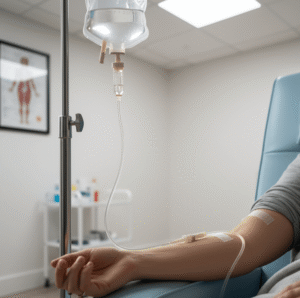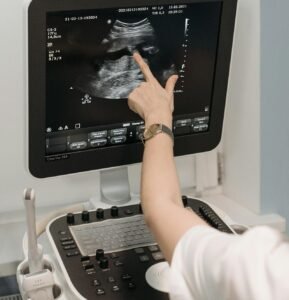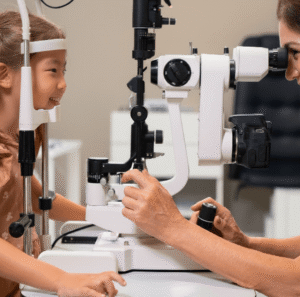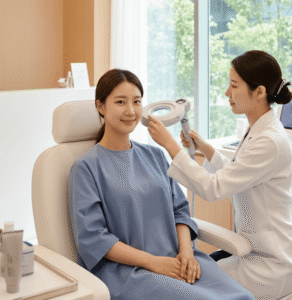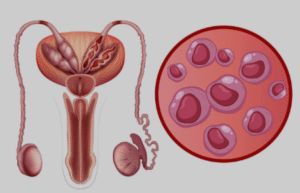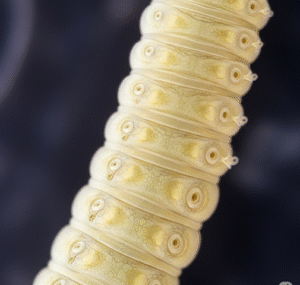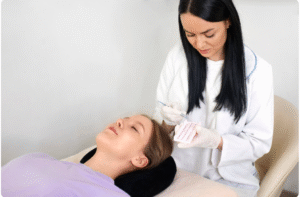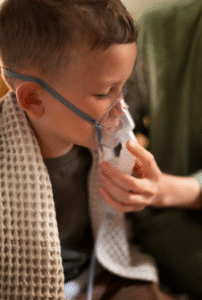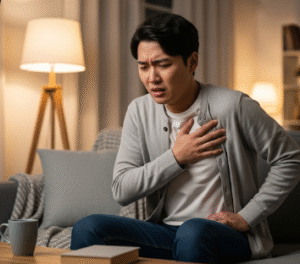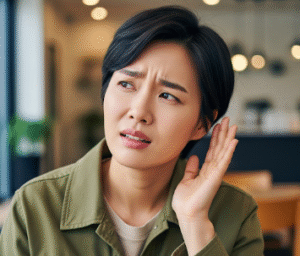What It Is
Defining Pityrosporum Folliculitis
→ Pityrosporum folliculitis (PF), also known as Malassezia folliculitis, is a skin condition caused by the overgrowth of yeast (Malassezia) within the hair follicles.
→ It produces small, uniform, itchy papules and pustules that closely resemble acne, often leading to misdiagnosis.
→ The yeast naturally lives on the skin but becomes problematic in conditions of excess oil, heat, humidity, sweating, or weakened immunity.
→ In Korea, dermatologists are skilled at distinguishing PF from acne and offer specialized antifungal therapies, skincare routines, and lifestyle counseling to manage it effectively.
Key Characteristics
- Small, red or skin-colored bumps often with tiny whiteheads
- Lesions are monomorphic (all look similar), unlike acne
- Intense itching (distinguishing feature from acne)
- Commonly affects chest, back, shoulders, and forehead
- Flares with heat, sweating, oily skincare, or antibiotic use
Why It’s Done
Main Reasons for Seeking Care
➡ Correct Diagnosis – PF is often mistaken for acne, leading to ineffective treatments.
➡ Relief from Itching – Symptoms can be very uncomfortable.
➡ Cosmetic Concerns – Bumps on visible areas like chest or forehead affect confidence.
➡ Prevent Recurrence – PF tends to relapse without proper care.
➡ Targeted Treatment – Antifungals are required instead of traditional acne medications.
Alternatives
Non-Medical Options
- Gentle Cleansing → Using mild, non-oily cleansers.
- Avoiding Heavy Creams/Oils → Reduces yeast overgrowth.
- Wearing Breathable Clothing → Prevents heat and sweat buildup.
- Showering After Exercise → Clears sweat and yeast from skin surface.
Medical Alternatives
→ When simple skincare adjustments aren’t enough:
- Topical Antifungals → Ketoconazole, clotrimazole, ciclopirox creams or shampoos.
- Oral Antifungals → Fluconazole or itraconazole for widespread or resistant cases.
- Topical Sulfur or Benzoyl Peroxide Washes → Reduce yeast and inflammation.
- Combination Therapy → Topical + oral antifungals for quicker results.
Preparation
Before Care in Korea
➡ Dermatology Evaluation – Careful exam to differentiate from acne vulgaris.
➡ History Review – Focus on sweating, heat exposure, skincare, antibiotic use, or steroid use.
➡ Diagnostic Tests – Korean dermatologists may perform:
- KOH test or fungal culture from pustules
- Wood’s lamp examination (sometimes shows fluorescence)
➡ Patient Counseling – Explanation that standard acne treatments (like antibiotics) may worsen PF, while antifungals are effective.
➡ Skincare Review – Patients often asked to bring their skincare products to check for oily or comedogenic ingredients.
How It’s Done
Standard Pityrosporum Folliculitis Care in Korea
1. Topical Antifungal Therapy
- Ketoconazole cream or shampoo applied to affected areas.
- Ciclopirox or clotrimazole creams for daily use.
- Shampoos used on scalp, face, chest, and back as a body wash.
2. Oral Antifungals
- Fluconazole or itraconazole prescribed for resistant or widespread PF.
- Short courses (1–2 weeks) often very effective.
- Requires monitoring of liver function in long-term use.
3. Adjunctive Therapies
- Benzoyl peroxide washes to reduce inflammation.
- Sulfur-based cleansers with antifungal and keratolytic properties.
- Korean clinics often combine antifungals with mild exfoliants to unclog follicles.
4. Skincare Adjustments
- Avoidance of oily sunscreens, creams, or cosmetics that worsen PF.
- Switching to oil-free, non-comedogenic products.
- Incorporation of K-beauty lightweight gel-based moisturizers suited for acne-prone skin.
5. Lifestyle Management
- Showering immediately after sweating or exercise.
- Wearing loose, breathable clothing in humid weather.
- Reducing intake of excessive sugar or dairy that may fuel yeast growth (advised in some clinics).
6. Maintenance Therapy
- Long-term use of antifungal shampoos once or twice a week as a preventive measure.
- Periodic follow-ups to adjust skincare routines and monitor recurrence.
Recovery
Immediate Recovery
- Itching improves within days of starting antifungals.
- Red bumps begin to flatten in 1–2 weeks.
Long-Term Recovery
→ PF is chronic and relapsing, but with ongoing skincare and antifungal maintenance, flare-ups become less frequent.
→ Patients in Korea often achieve clear skin within weeks and maintain results with preventive strategies.
→ Cosmetic dermatology integration also helps treat post-inflammatory pigmentation or scarring from PF.
Complications
Risks Without Proper Care
- Persistent Rash – Without antifungal therapy, PF does not resolve.
- Misdiagnosis – Patients treated as “acne” may worsen with antibiotics.
- Secondary Infection – Scratching may lead to bacterial infection.
- Chronic Pigmentation – Repeated flares leave dark marks, especially in Asian skin.
Risks With Treatment
- Topical Irritation – Rare itching or burning from antifungal creams.
- Oral Antifungal Side Effects – Possible liver issues if used long-term.
- Recurrence – PF often returns if maintenance is not followed.
Treatment Options in Korea
Why Korea Excels in Pityrosporum Folliculitis Care
➡ Accurate Differentiation – Korean dermatologists are highly skilled in distinguishing PF from acne.
➡ Access to Advanced Antifungal Therapies – Both topical and oral options readily available.
➡ Integration with Cosmetic Dermatology – Management of pigmentation and scars alongside antifungal care.
➡ Patient Education Culture – Strong emphasis on lifestyle adjustments and skincare counseling.
➡ K-Beauty Product Innovation – Patients benefit from lightweight, yeast-safe, non-comedogenic skincare lines.
Patient Experience in Korea
- Diagnosis is outpatient-based with quick turnaround.
- Clinics provide customized skincare kits (antifungal shampoos, cleansers, lightweight moisturizers).
- Patients receive step-by-step lifestyle guidance for sweat, exercise, and skincare.
- Many clinics combine medical + cosmetic treatments to ensure clear skin and confidence.
Conclusion
Pityrosporum folliculitis care in Korea is a specialized, accurate, and holistic process that combines medical antifungal therapy, lifestyle adjustments, and skincare counseling.
Through topical and oral antifungals, preventive maintenance, and cosmetic support, Korean dermatologists provide effective relief and reduce recurrence.
With Korea’s expertise in differentiating PF from acne, innovative K-beauty solutions, and advanced dermatology practices, patients achieve both medical control and cosmetic satisfaction.
For those struggling with persistent “acne-like bumps” and itching, Korea offers some of the most advanced and reliable PF care programs worldwide.


